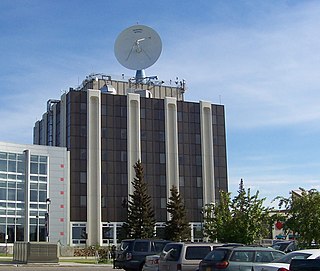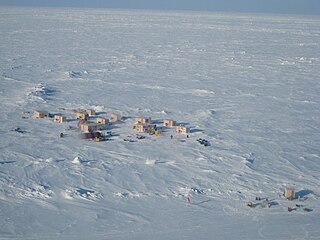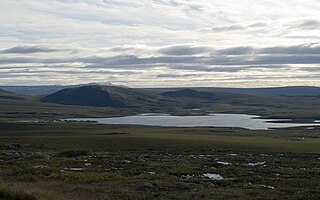
The Department of Plant & Microbial Biology is an academic department in the College of Natural Resources at the University of California, Berkeley. The department conducts extensive research, provides undergraduate and graduate programs, and educates students in the fields of plant and microbial sciences with 43 department faculty members.

The University of Alaska Fairbanks is a public land-grant research university in College, Alaska; a suburb of Fairbanks. It is a flagship campus of the University of Alaska system. UAF was established in 1917 and opened for classes in 1922. Originally named the Alaska Agricultural College and School of Mines, it became the University of Alaska in 1935. Fairbanks-based programs became the University of Alaska Fairbanks in 1975.

The National Wildlife Federation (NWF) is the United States' largest private, nonprofit conservation education and advocacy organization, with over six million members and supporters, and 51 state and territorial affiliated organizations.
Hydrobiology is the science of life and life processes in water. Much of modern hydrobiology can be viewed as a sub-discipline of ecology but the sphere of hydrobiology includes taxonomy, economic biology, industrial biology, morphology, physiology etc. The one distinguishing aspect is that all relate to aquatic organisms. Much work is closely related to limnology and can be divided into lotic system ecology and lentic system ecology.
The Alaska Agricultural and Forestry Experiment Station (AFES) was established in 1898 in Sitka, Alaska, also the site of the first agricultural experiment farm in what was then Alaska Territory. Today the station is administered by the University of Alaska Fairbanks through the School of Natural Resources and Agricultural Sciences. Facilities and programs include the Fairbanks Experiment Farm, the Georgeson Botanical Garden, the Palmer Research and Extension Center, the Matanuska Experiment Farm, and the Reindeer Research Program.

The Geophysical Institute of the University of Alaska Fairbanks conducts research into space physics and aeronomy; atmospheric sciences; snow, ice, and permafrost; seismology; volcanology; and tectonics and sedimentation. It was founded in 1946 by an act of the United States Congress.
F. Stuart Chapin III is a professor of Ecology at the Department of Biology and Wildlife of the Institute of Arctic Biology, University of Alaska. He was President of the Ecological Society of America (ESA) from August 2010 until 2011.

The Applied Physics Laboratory Ice Station 2007 (APLIS07) is a U.S. and Japanese laboratory dedicated to the study of global climate change, located about 300 kilometres (190 mi) south of the Arctic Circle, Alaska on the West Ridge of the University of Alaska Fairbanks campus.
Virgil L. (Buck) Sharpton is the Associate Director for Science at the Lunar and Planetary Institute (LPI) in Houston, Texas. Prior to joining the LPI in 2011, he was Vice Chancellor for Research at the University of Alaska Fairbanks (UAF). He is also the founder and former director of the Geographic Information Network of Alaska (GINA) which provides access to university data and information services across the state.

Harvard Forest is an ecological research area of 3,000 acres (12 km2) owned and managed by Harvard University and located in Petersham, Massachusetts. The property, in operation since 1907, includes one of North America's oldest managed forests, educational and research facilities, a museum, and recreation trails. Harvard Forest is open to the public.
Nicholas Farrar Hughes was an English-American fisheries biologist known as an expert in stream salmonid ecology. Hughes was the son of the American poet Sylvia Plath and English poet Ted Hughes, and the younger brother of artist and poet Frieda Hughes. He and his sister were well known to the public through the media when he was a small child, especially after the well-publicized suicide of his mother. Hughes held dual British/American citizenship.
David Cameron Duffy is an American professor of botany and zoology at the University of Hawai'i and Director of the Hawaiian Pacific Island Cooperative Ecosystem Studies Unit.

The Arctic policy of the United States is the foreign policy of the United States in regard to the Arctic region. In addition, the United States' domestic policy toward Alaska is part of its Arctic policy.

The College of Fisheries and Ocean Sciences, or CFOS, is part of the University of Alaska Fairbanks. CFOS offers a bachelor of arts and a bachelor of science in fisheries, master’s and doctoral degrees in oceanography, fisheries and marine biology, and a minor in marine science.
The College of Natural Resources and Environment at Virginia Tech contains academic programs in forestry, fisheries, wildlife sciences, geography, and wood science. The college contains four departments as well as a graduate program in the National Capital Region and a leadership institute for undergraduates.

The H.J. Andrews Experimental Forest, commonly referred to as Andrews Forest, is located near Blue River, Oregon, United States, and is managed cooperatively by the United States Forest Service's Pacific Northwest Research Station, Oregon State University, and the Willamette National Forest. It was one of only 610 UNESCO International Biosphere Reserves, until being withdrawn from the program as of June 14, 2017, and a Long Term Ecological Research site. It is situated in the middle of the Western Cascades.
Jill Johnstone was a professor in the Department of Biology at the University of Saskatchewan, where she started the Northern Plant Ecology Lab (NPEL) which she still runs. She primarily conducts research on plant ecology and environmental biology with an emphasis on how boreal forest and tundra are responding to rapid rates of climate change.
Anne E. Giblin is a marine biologist who researches the cycling of elements nitrogen, sulfur, iron and phosphorus. She is a Senior Scientist and Acting Director of the Ecosystem Center at the Marine Biological Lab.
Brina Cattell Kessel was an American ornithologist.

Toolik Lake is an Arctic lake located within the North Slope Borough, Alaska. It is in a remote wilderness area managed by the Bureau of Land Management accessed by the Dalton Highway. It is 130 mi (210 km) south of Prudhoe Bay in the northern foothills of the Brooks Range. The name is derived from the Iñupiat word tutlik, meaning yellow-billed loon.










